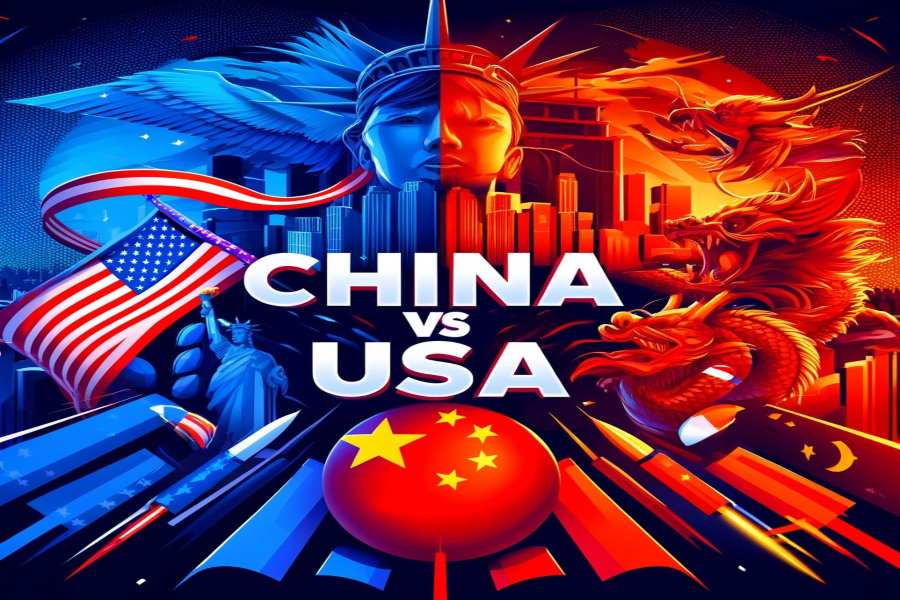Whether China can emerge as a contender to the long-standing dominance of the United States looms large. As the world’s two largest economies, their competition extends far beyond mere economic rivalry, encompassing military might, technological innovation, and soft power projection. This article delves into the multifaceted aspects of this power struggle, examining historical trajectories, economic prowess, military capabilities, and the influence of technological advancements. By scrutinizing these factors, we seek to unravel the complexities of the China-USA dynamic and provide insights into the future landscape of global geopolitics.
Understanding The Rise Of China And The USA
China’s and the United States’ ascension to their current positions as global powerhouses is not a result of chance but rather rooted in distinct historical trajectories. These trajectories were shaped by unique socio-political, economic, and technological developments, which we will explore in this article.
China’s ascent as a global economic and geopolitical force can be traced back to the late 20th century, a period marked by Deng Xiaoping’s economic reforms in the late 1970s. These reforms, which ushered in an era of rapid industrialization, urbanization, and export-led growth, propelled China to become the world’s factory floor. China’s geopolitical ambitions have also been bolstered by initiatives such as the Belt and Road Initiative (BRI), a project aimed at expanding its influence across Asia, Africa, and beyond.
The United States, on the other hand, emerged as a global superpower following World War II. Endowed with abundant natural resources, technological innovation, and a liberal democratic system, the USA established itself as the leader of the free world. Its economic prowess, exemplified by the Marshall Plan and the establishing of institutions like the World Bank and the International Monetary Fund (IMF), laid the foundation for the post-war economic order. Additionally, the USA’s military supremacy, evidenced by its unmatched military spending and global network of alliances, solidified its position as the preeminent global hegemon during the Cold War era.
A comparative analysis of China and the USA reveals contrasting trajectories of growth and development. While China’s rise has been characterized by rapid industrialization and export-driven growth, technological innovation, financial prowess, and military supremacy have sustained the USA’s dominance. Furthermore, China’s state-led economic model contrasts with the USA’s market-driven capitalism, leading to divergent economic policy and governance approaches.
Key Factors Influencing The Power Dynamics Between China And The USA
The evolving power dynamics between China and the USA are influenced by many interconnected factors spanning economic, military, technological, and soft power domains. Understanding these key factors is essential for comprehending the complexities of their geopolitical rivalry and forecasting future trends.
Economic Interdependence:
Economic ties between China and the USA form a cornerstone of their relationship, characterized by extensive trade relations, investment flows, and financial interdependence. Both countries are major trading partners, with China holding a significant share of US debt by purchasing Treasury securities. However, this economic interdependence is also vulnerable, as evidenced by trade tensions, tariff wars, and geopolitical rivalries over strategic industries such as technology and energy.
Military Capabilities and Strategic Posturing:
Military strength and strategic positioning are crucial in shaping the power dynamics between China and the USA. While the USA maintains the world’s most powerful military, with unparalleled capabilities in conventional warfare, nuclear deterrence, and global power projection, China has invested heavily in modernizing its armed forces, particularly its navy and missile capabilities. This has increased tensions in contested regions such as the South China Sea and Taiwan Strait, where both countries assert their strategic interests.
Technological Innovation and Competition:
The race for technological supremacy has emerged as a defining feature of the China-USA power struggle. Both countries vied for dominance in cutting-edge fields such as artificial intelligence, quantum computing, and 5G telecommunications. China’s state-led initiatives, such as Made in China 2025 and the Digital Silk Road, aim to bolster its technological capabilities and reduce dependency on foreign technologies. The USA has implemented measures to safeguard its technological edge, including export controls, investment screening, and research partnerships with allies.
Soft Power and Influence:
Soft power and cultural influence play a significant role in shaping perceptions and garnering support on the global stage. While the USA has traditionally been a cultural and ideological beacon, projecting its values of democracy, freedom, and consumerism through Hollywood, Silicon Valley, and multinational corporations, China has also sought to expand its soft power through initiatives like the Confucius Institutes, cultural diplomacy, and media outlets like CGTN. However, China’s authoritarian governance, human rights violations, and assertive foreign policy have posed challenges to its soft power aspirations.
Geopolitical Alliances and Regional Dynamics:
Geopolitical alliances and regional dynamics further complicate the China-USA power equation. The USA’s network of alliances in Asia, Europe, and beyond is a force multiplier, bolstering its influence and military presence across critical regions. Conversely, China’s Belt and Road Initiative (BRI) seeks to enhance its connectivity and influence through infrastructure development and economic partnerships across Asia, Africa, and Europe. Regional flashpoints such as North Korea, Iran, and the Indo-Pacific also shape the strategic calculus of both countries.
Military Strength And Strategic Capabilities
China’s and the USA’s military strength and strategic capabilities are pivotal in shaping the global balance of power and influencing geopolitical dynamics. A comprehensive analysis of their military prowess encompasses various dimensions, including budget allocation, personnel strength, technological advancements, and strategic posturing.
Budget Allocation: The USA consistently allocates the largest defense budget globally, considerably outspending China and other major powers. This substantial investment enables the USA to maintain a technologically advanced military, fund research and development projects, and sustain a global network of military bases and operations. In contrast, while China’s defense budget has been steadily increasing, it remains significantly lower than the USA’s, limiting its capacity for extensive military expansion and modernization.
Personnel Strength and Recruitment: The USA boasts one of the world’s most professional and technologically proficient military forces, comprising millions of active-duty personnel across all branches – Army, Navy, Air Force, Marines, and Space Force. Additionally, the USA benefits from a robust recruitment and training infrastructure, drawing from a vast pool of volunteers and conscripts. Conversely, China maintains the largest standing army globally, with millions of active-duty personnel, supplemented by reserves and paramilitary forces. However, China’s military relies heavily on conscription and faces challenges in recruiting and retaining skilled personnel.
Technological Advancements: Technological innovation and advancements in defense capabilities are crucial in enhancing military effectiveness and maintaining strategic superiority. The USA leads in several key areas of military technology, including aerospace, cyber warfare, unmanned aerial vehicles (UAVs), and missile defense systems. Moreover, the USA benefits from a robust defense industrial base comprising leading aerospace and defense companies, research institutions, and government agencies. In contrast, while China has made significant strides in military modernization and indigenous defense production, it still lags behind the USA in critical areas such as stealth technology, aircraft carriers, and nuclear submarines.
Strategic Posturing and Power Projection: China and the USA use strategic posturing and power projection to safeguard their national interests, assert regional influence, and deter potential adversaries. The USA maintains a global network of military alliances and bases, enabling it to project power across multiple theaters and respond rapidly to emerging threats. Furthermore, the USA possesses unmatched power-projection capabilities, including aircraft carriers, stealth bombers, and forward-deployed forces. Conversely, China has adopted a more regionally focused approach, emphasizing the development of anti-access/area denial (A2/AD) capabilities, asymmetric warfare strategies, and a blue-water navy to counter US dominance in the Indo-Pacific region.
Analysis Of Technological Innovation Ecosystems In China And The USA
Technological innovation is a driving force behind economic growth, military superiority, and global competitiveness. Examining the innovation ecosystems of China and the USA provides valuable insights into their respective strengths, weaknesses, and future trajectories in science and technology.
Research and Development (R&D) Infrastructure:
- The USA possesses a robust R&D infrastructure comprising world-renowned universities, research institutions, and private sector entities. Institutions like NASA, DARPA, and the National Institutes of Health (NIH) spearhead groundbreaking aerospace, defense, healthcare, and biotechnology research.
- China has invested significantly in R&D infrastructure, establishing numerous universities, research institutes, and innovation hubs nationwide. Initiatives such as the “Double First-Class” project aim to elevate Chinese universities and research institutions to global prominence.
Government Support and Policy Environment:
- The USA benefits from a supportive policy environment, with government initiatives promoting innovation through tax incentives, research grants, and public-private partnerships. Agencies like the National Science Foundation (NSF) and the Department of Defense (DoD) allocate substantial funding to advance scientific research and technological development.
- China’s government plays a central role in driving technological innovation, with initiatives like “Made in China 2025” and the “National Innovation-Driven Development Strategy” prioritizing key sectors such as advanced manufacturing, information technology, and biotechnology. State-backed investment funds and subsidies support research, development, and commercialization efforts.
Entrepreneurship and Start-up Culture:
- The USA boasts a vibrant entrepreneurial ecosystem, with Silicon Valley serving as a global hub for technology startups and venture capital investment. The culture of risk-taking, innovation, and collaboration fosters disruptive technologies’ rapid development and commercialization.
- China’s startup landscape has experienced exponential growth in recent years, fueled by a large pool of talented engineers, abundant capital, and government support for entrepreneurship. Tech clusters like Zhongguancun in Beijing and Shenzhen’s Huaqiangbei district have emerged as hotbeds of innovation, attracting domestic and international talent.
Intellectual Property Protection and Enforcement:
- Intellectual property (IP) protection is critical for China and the USA. While the USA has well-established legal frameworks and enforcement mechanisms to safeguard IP rights, concerns persist regarding IP theft, corporate espionage, and cybersecurity threats.
- China has taken steps to strengthen its IP protection regime, enacting laws and regulations to address concerns raised by foreign investors. However, challenges remain in enforcing IP rights and combating infringement, particularly in the face of complex supply chains and state-sponsored industrial espionage.
International Collaboration and Knowledge Exchange:
- Collaboration between academia, industry, and government fosters knowledge exchange and technological advancement. The USA has a long tradition of international collaboration, with researchers and institutions participating in global networks, joint projects, and collaborative initiatives.
- China collaborates internationally, leveraging partnerships with foreign universities, research institutions, and multinational corporations to access cutting-edge technologies, expertise, and resources. Initiatives like the “Thousand Talents Plan” attract top-tier researchers and scholars worldwide to contribute to China’s innovation ecosystem.
Bottom Line
China and the USA possess dynamic technological innovation ecosystems with robust research infrastructure, government support, entrepreneurial culture, and international collaboration. While the USA maintains a lead in critical areas such as R&D investment, IP protection, and startup culture, China is rapidly catching up, leveraging state-driven initiatives, abundant talent, and strategic partnerships to advance its technological capabilities. Understanding the strengths and weaknesses of these ecosystems is crucial for policymakers and industry leaders navigating the evolving landscape of global innovation.
FAQ’s
What are the consequences of a China-US conflict?
Explore the potential impact of a conflict between China and the USA on global stability, security, and economic prosperity.
Can China become more powerful than the USA?
Examine the various factors influencing China’s rise and assess its trajectory towards surpassing the USA in power and influence.
How does the USA view China’s rise?
Understand the USA’s perspectives and policies toward China’s growing economic, military, and technological prowess.











Leave a Reply